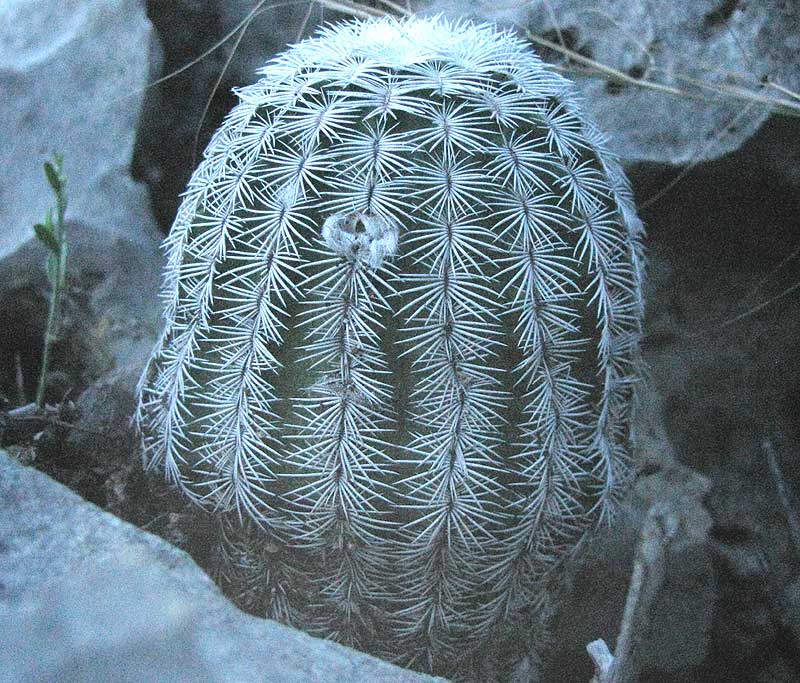Excerpts from Jim Conrad's
Naturalist Newsletter

from the June 30, 2013 Newsletter issued from the Frio Canyon Nature Education Center in the valley of the Dry Frio River in northern Uvalde County, southwestern Texas, on the southern border of the Edwards Plateau; elevation ~1750m (~5750 ft); N29.62°, W99.86°; USA
LACE CACTUS BY MOONLIGHT
Our neighbor Dave invited us to his ranch to look around. One thing he showed us was a curious stratum of limestone outcropping on one of his hillsides. The white stone was honeycombed as if tunneled through by thousands of worms, some tunnels only finger wide, others big enough to put a fist in. The stone was nice but what really was exciting was the plants living in natural bowls formed wherever the honeycombed rock outcropped. For instance, there was the four-inch-tall (10cm) cactus shown above.
That picture is a bit monochromatic and bluish because we visited the hill during that magical hour after sunset known by photographers as the blue hour, after the French expression l'heure bleue. At this hour the landscape was illuminated by light reflected from the sky. It happens that light of shorter wavelengths -- at the blue end of the light spectrum -- scatters more readily in the atmosphere than red light of longer wavelength, so that early evening everything was tinted blue, and cameras seem to document the phenomenon more than our own eyes.
Anyway, it was the blue hour and the amazing full moon you probably noticed last weekend was rising over the hill, so really the cactus was lighted as much by the Moon as by the dimming sky. The above picture is a time exposure of four seconds duration. The fuzzy thing near the cactus's center is a feather caught among the spines. A close-up of the cactus's spine clusters appears below:

From the cactus's barrel shape and the distinctive disposition of its spines I recognized it as a kind of hedgehog cactus, genus Echinocereus. However, about 23 species of hedgehog cactus are known to live in North America, and several occur in southwestern Texas, so which one was this?
The white spines spreading so systematically from their long, slender base areas, or areoles, with no spines arising from the narrow areole surface between the bases of the marginal spines indicate that this is ECHINOCEREUS REICHENBACHII, mostly known as the Lace Hedgehog or simply Lace Cactus.
The Lace Hedgehog's main homeland is northern Mexico's Chihuahuan Desert but in the US its distribution extends up through the central states as far north as Kansas and Colorado. That makes this the most northerly occurring Echinocereus, and one treasured by rock gardeners for its ability to survive fairly cold temperatures.
The Flora of North America says, "The taxonomic and geographic boundaries among the segregate species or numerous proposed infraspecific taxa of Echinocereus reichenbachii remain nebulous and controversial." In other words, the experts are having a hard time fitting this species into a decent pigeonhole, even in this time of promiscuous gene sequencing.
I like the idea of finding a nebulous and controversial Lace Hedgehog lighted by moonlight on Dave's hill. Lace Hedgehogs produce glorious blossoms large out of all proportion to their small body size, and that's something I hope to eventually see and show you.